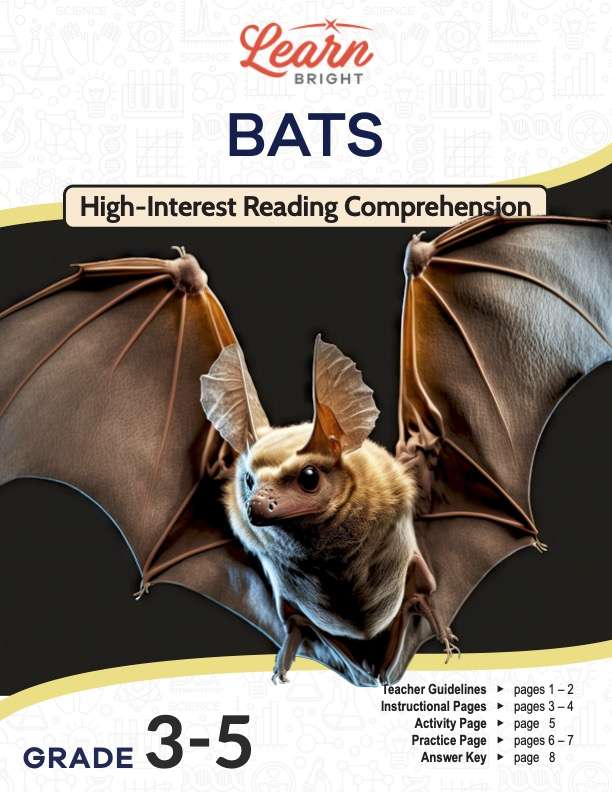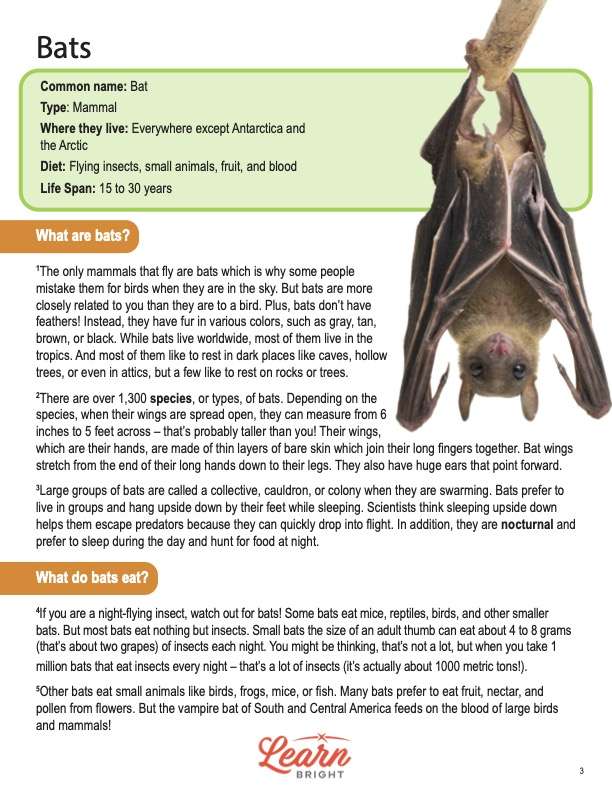Description
What our Bats lesson plan includes
Lesson Objectives and Overview: Bats is a high-interest reading comprehension lesson plan. As such, students will practice various close reading and comprehension skills. In addition, they will learn about the bat’s habitat, diet, and behaviors. This lesson is for students in 3rd grade, 4th grade, and 5th grade.
Classroom Procedure
Every lesson plan provides you with a classroom procedure page that outlines a step-by-step guide to follow. You do not have to follow the guide exactly. The guide helps you organize the lesson and details when to hand out worksheets. It also lists information in the yellow box that you might find useful. You will find the lesson objectives, state standards, and number of class sessions the lesson should take to complete in this area. In addition, it describes the supplies you will need as well as what and how you need to prepare beforehand.
Teacher Notes
The teacher notes page provides an extra paragraph of information to help guide the lesson and remind you what to focus on. It explains that you can teach this lesson in a whole-class setting or to an independent, small group as an activity. The blank lines on this page are available for you to write out thoughts and ideas you have as you prepare the lesson.
BATS LESSON PLAN CONTENT PAGES
Intro to Bats
The Bats lesson plan contains two content pages. To start off, it provides a little basic background information about bats. This animal is a type of mammal that lives basically everywhere, except for in the Arctic and Antarctica. A bat’s diet includes flying insects, small animals, fruit, and blood. They can live between 15 and 30 years.
Interestingly enough, bats are the only mammals that fly, which is why some people mistake them for birds when they are in the sky. But bats are more closely related to you than they are to a bird. Plus, bats don’t have feathers! Instead, they have fur in various colors, such as gray, tan, brown, or black. While bats live worldwide, most of them live in the tropics. And most of them like to rest in dark places like caves, hollow trees, or even in attics. However, a few like to rest on rocks or trees.
There are over 1,300 species of bats. Depending on the species, a bat’s wings can measure from 6 inches to 5 feet across when spread out. Their wings, which are their hands, are made of thin layers of bare skin that join their long fingers together. Bat wings stretch from the end of their long hands down to their legs. They also have huge ears that point forward.
A large group of bats is called a collective, cauldron, or colony when they are swarming. Bats prefer to live in groups and hang upside down by their feet while sleeping. Scientists think sleeping upside down helps them escape predators because they can quickly drop into flight. In addition, they are nocturnal and prefer to sleep during the day and hunt for food at night.
What They Eat and Other Interesting Facts
If you are a night-flying insect, watch out for bats! Some bats eat mice, reptiles, birds, and other smaller bats. But most bats eat nothing but insects. Small bats the size of an adult thumb can eat about 4 to 8 grams (that’s about two grapes) of insects each night. You might think that’s not a lot. But when you take a million bats that eat insects every night, that’s a lot of insects. In fact, it’s actually about 1,000 metric tons!
Other bats eat small animals like birds, frogs, mice, or fish. Many bats prefer to eat fruit, nectar, and pollen from flowers. But the vampire bat of South and Central America feeds on the blood of large birds and mammals!
While in flight, bats send out a cry from their mouths or noses that is so high-pitched, people cannot hear it. The sound helps them figure out how far away they are from particular objects and what the size of the object is. That sound bounces off of objects and echoes back to the bat. Using the sound waves, they can create a picture of exactly what’s around them. This is called echolocation.
Echolocation enables bats to avoid flying into objects in their path and to locate insects to eat. When they find an insect, they trap it with their wings or tail and then reach over to put it in their mouth. Unfortunately, chasing and eating insects using echolocation often makes their flight pattern look erratic or uneven rather than smooth like birds.
The saying “blind as a bat” is inaccurate because bats have excellent eyesight, and extraordinary hearing. The bat is so unique that some ancient civilizations worshiped them. For example, the Aztecs had many different gods. Their god of the dead was called Mictlāntēcuhtli, who had a scrunched, bat-like face and clawed hands and feet.
Why They Are Important
Just like bees and butterflies, bats are pollinators as they fly from plant to plant in search of food. Hundreds of plants, like bananas, mangoes, and avocados, rely on bats to pollinate them. Bats also help spread seeds for nuts, figs, and cacao, the main ingredient in chocolate. Without bats, we might not have delicious chocolate desserts! They also play an extremely important role in pest control. By eating literally tons of insects a night, they help stop crop damage and decrease pesticide use.
But sadly, populations of bats are declining across the globe. People kill bats when they don’t have to because they don’t understand their importance to the ecosystem. And because of human progress and activity, bats are losing many of their caves for shelter, causing habitat loss. Since 2006, five million bats have died from white-nose syndrome disease. But with knowledge and protection, we can help the number of bats soar again!
BATS LESSON PLAN WORKSHEETS
The Bats lesson plan includes two worksheets: an activity worksheet and a practice worksheet. Each one will help students solidify their grasp of the material they learned throughout the lesson. You can refer to the classroom procedure guidelines to know when to hand out each worksheet.
TUNE ON IN PODCAST ACTIVITY WORKSHEET
Students will work in small groups for the activity. To help the bat population grow again, people should know about bats and their essential contribution to the environment. One way to do that is through raising awareness through a podcast. For the activity, students will create a podcast about bats.
They will first choose a specific topic about bats that they want to teach others about. The worksheet provides some ideas that might interest students, such as how bats help people, what bat wings are, and why they sleep upside down. Students will write a 3–5 minute script and record the podcast. They can use the graphic organizer on the bottom of the worksheet page to help gather and organize their information.
BATS PRACTICE WORKSHEET
The practice worksheet lists 11 questions based on the content. These questions all relate to the content pages, so students will need to refer to them often for the answers. In addition, each question provides which reading tool the question corresponds to, such as text feature, vocabulary, or comprehension.
Worksheet Answer Keys
At the end of the lesson plan document is an answer key for the practice worksheet. The correct answers are all in red to make it easier for you to compare them with students’ responses. If you choose to administer the lesson pages to your students via PDF, you will need to save a new file that omits these pages. Otherwise, you can simply print out the applicable pages and keep these as reference for yourself when grading assignments.










